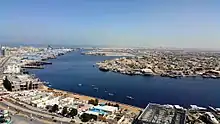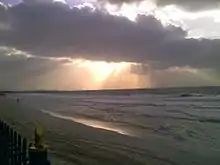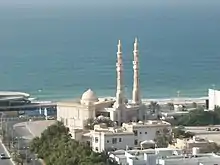Emirate of Ajman
The Emirate of Ajman (Arabic: إمارة عجمان; pronounced [ʔɪmaːra(t) ʕaʤmaːn]) is one of the seven emirates (states) of the United Arab Emirates. It has an area of a mere 260 square kilometres (100 sq mi), which makes it the smallest of the emirates in terms of area,[5] while its population of approximately 500,000 makes it the fourth most populous emirate in the country. It is named after the city of Ajman, which is its seat of government. The main landmass of the emirate is bordered on the north, east, and south by the Emirate of Sharjah.[6]
Ajman
إمارة عجمان Imārat ʿAǧmān | |
|---|---|
| Emirate of Ajman | |
 Flag  Coat of arms | |
 Location of Ajman in the UAE | |
| Coordinates: 25°25′N 55°30′E | |
| Country | |
| Emirate | |
| Subdivisions | |
| Government | |
| • Type | Absolute Islamic monarchy[1][2][3] [4] |
| • Emir | Humaid bin Rashid Al Nuaimi III |
| Area | |
| • Total | 259 km2 (100 sq mi) |
| Area rank | 7th |
| Population (2017) | |
| • Total | 504,846 |
| • Rank | 4th |
| Demonym(s) | Ajmani |
| Time zone | UTC+4 (UAE Standard Time) |
| ISO 3166 code | AE-AJ |
Located on the coast of the Persian Gulf, Ajman also controls two small inland exclaves: Manama and Masfout, both of which are primarily agricultural. Approximately 95% of the population of the emirate resides in the city of Ajman, which forms part of the Dubai-Sharjah-Ajman metropolitan area. Ajman is ruled by Sheikh Humaid bin Rashid Al Nuaimi III of the Na'im tribe. The Crown Prince of the Emirate is Sheikh Ammar bin Humaid Al Nuaimi.
Geography

Ajman is the smallest of the United Arab Emirates, covering only 260 square kilometres (100 sq mi). The city lies on the coast of the Persian Gulf and is home to some 95% of the emirate's population. In 2010, the population was 262,000, of which 16% was Emirati according to official statistics.[7]
Manama and Masfout
As well as the city of Ajman, the emirate also encompasses two landlocked exclaves, Manama and Masfout. Manama is in the plains at the foothills of the Hajjar Mountains some 60 km east of Ajman city, while Masfout is in the mountains proper, some 110 km south of Ajman City.
The city and main territory of Ajman is bordered to the landward side by Sharjah, while Manama shares borders with Sharjah and Fujairah. Masfout borders Oman, Dubai (the village and exclave of Hatta) and Ras Al Khaimah. Both Manama and Masfout are fertile regions and support widespread agricultural development.
Most of the main emirate's landmass is developed, with extensive suburbs stretching out almost to the E311 arterial road, with light industrial zones and warehousing towards the north east. Ajman's creek has been dredged and walled to form a port area and this is the location for the Ajman Port and the Ajman Free Zone.[8] Ajman has a thriving textile industry, and is home to some 15% of the UAE's manufacturing firms.[9]
The small areas of sandy desert outside the city support scant seasonal growths of wild grasses and scrub, ghaf trees and occasional date palms.[10] Acacia and ghaf trees are to be found in abundance in Manama, which has long been established as an agricultural centre. Date palm groves and fruit tree plantations are characteristic of Masfout.
Governance
The Emirate of Ajman is a monarchy, ruled by Sheikh Humaid bin Rashid Al Nuaimi III since succeeding his father in 1981. The Crown Prince of Ajman is Sheikh Ammar bin Humaid Al Nuaimi. The emirate has been ruled by members of the Al Nuaimi family (or tribe) since 1810. It contributes four senators, or seats, to the 40-seat Federal National Council of the United Arab Emirates.
Ajman's municipality and planning department was founded in 1968 and is responsible for integrated city planning, trade licensing, building licensing and planning and the development of roads and civic infrastructure, health care, agricultural policy and public parks. Sheikh Rashid bin Humaid Al Nuaimi is the Chairman of Ajman Municipality and Planning Department since 2005. Ajman has a Department of Economic Development, which aims to encourage FDI and drive the emirate's economic opportunities.
Ajman's real estate market is regulated by the Ajman Real Estate Regulatory Authority, established in December 2008 to bring regulation to bear on Ajman's fast growing and uncontrolled property boom.
Rulers
Its rulers were:[11]
- 1816–1838 Sheikh Rashid bin Humaid Al Nuaimi (d. 1838)
- 1838–1841 Sheikh Humaid bin Rashid Al Nuaimi (1st time) (b.1816 – d.1864)
- 1841–1848 Sheikh Abdelaziz bin Rashid Al Nuaimi (d.1848)
- 1848–1864 Sheikh Humaid bin Rashid Al Nuaimi (2nd hi time)
- 1864 – April 1891 Sheikh Rashid bin Humaid Al Nuaimi II (b.1841 – d.1891)
- April 1891 – 8 July 1900 Sheikh Humaid bin Rashid Al Nuaimi II (d. 1900)
- 8 July 1900 – February 1910 Sheikh Abdulaziz bin Humaid Al Nuaimi (b. 18.. – d. 1910)
- February 1910 – January 1928 Sheikh Humaid bin Abdulaziz Al Nuaimi
- January 1928 – 6 September 1981 Sheikh Rashid bin Humaid Al Nuaimi III (b. 1904 – d. 1981)
- 6 September 1981–present Sheikh Humaid bin Rashid Al Nuaimi III (b. 1931)
Law Enforcement
Ajman Police was founded in 1967 and originally housed in Ajman Fort, which was vacated by the Ruler, Sheikh Rashid Bin Humaid Al Nuaimi, in that year. Ajman's legal system is governed by UAE Federal law and the Federal courts.
Economy

Ajman's GDP was $4.23 billion in 2012,[12] in which it had a positive trade balance with exports of $1.61 billion and imports of $600 million.[13]
Ajman's economy is dominated by five sectors, manufacturing; construction; wholesale and retail; real estate and business services and transport, storage and communications. In 2012 these contributed some 82% of total GDP, with manufacturing (37%) and construction (15%) the two largest contributors. The three largest growth sectors in Ajman from 2010 to 2012 were social and personal services, which grew 6.4%, transport, storage and communication, which grew 5.1% and manufacturing, which grew 5%.[12]
Some 78% of overall investment in Ajman in 2012 was concentrated in the real estate and government services, electricity and manufacturing.
Ajman is also home to many businesses and manufacturing concerns such as Amtek Industries, Al Haramain Perfumes and the Gulf Medical University.
The fastest growing trades in the manufacturing sector 2009-2011 were carpentry and paper products, printing and publishing. Overall, the manufacturing sector in Ajman grew 16.3% over this period.[14] The re-exporting of chemicals and plastic products clocked over 100% growth in this same time period.
Major export markets from 2009 to 2011 were represented by the GCC countries (31%) and Asia (27%), while Africa and Asia were the fastest growing export markets over this period. Saudi Arabia, Qatar, Oman and Iran were the Ajman's principal export trade partners.[14]
Investments in Ajman grew in 2013 by 5% compared to 2012. Exports (including re-export) grew in the second quarter of 2014 by 53%.[15]
Ajman Free Zone
With capacity to accommodate 1500 companies and serving over 1,000 vessels a year, Ajman Port and Ajman Free Zone are major contributors to the emirate's economy. Exporting to over 65 countries, the Free Zone's companies comprise something like 20% of the UAE's overall industrial units, with some 256 industrial companies operating from the zone.[16]
Real estate
Ajman was the first emirate in the UAE to offer 100% freehold to global investors, in 2004. This led to real estate prices rising rapidly, from $11 per square foot and, by 2007, developers had announced projects with a worth of $21.78 billion, some 65,000 units in all.[17] In an emirate with a population of 240,000 the figure was high by any standard and the pace of development was not sustainable, with the global financial crisis intervening to bring development to a sharp halt. With considerable pain from investors in stalled projects, the Ajman Real Estate Regulatory Agency came under considerable pressure.
Work has restarted on a number of projects, including the mixed business, leisure and residential development Ajman One.
Recent developments

A development boom followed the opening of Ajman's real estate market to global investors in 2004, with 'true' freehold on offer.[17] By 2008 the growth of real estate speculation and investment had led to the establishment of a real estate regulator, the Ajman Real Estate Regulatory Agency. Arguably ineffective in the face of the fast-moving and evolutionary gold rush taking place, ARERA had not implemented widespread policies or regulations to curb the overheating market by the time the global financial crisis intervened and brought many developments to a crashing halt. As of 2014, a number of key stalled projects had restarted, marking a more cautious and measured return to the development of the emirate's real estate market, which has recently benefited from offering competitive rentals to nearby Sharjah and Dubai.[18]
The construction of Ajman International Airport began in the second half of 2008 in the Al Manama area of Ajman. Airport operations were scheduled to begin by 2011, and the airport was expected to host about two million passengers per year. The project stalled but has now been restarted and is projected to be completed by 2018[19] and will entail an investment of some $575m.[20]
A$25 million marina project is also underway, which will include running tracks and facilities to attract international sporting events and provide a draw for tourism to the emirate.[20]
Places of interest

Ajman Fort was formerly the residence of the Ruler of Ajman but turned over to Ajman Police as their barracks in 1967. It was subsequently converted into a museum and houses an eclectic collection of artefacts and exhibitions of traditional life in Ajman.
The Red Fort was built during Sheikh Humaid bin Abdul Aziz Al Nuaimi (1910–1928), and consists of four rooms in two towers. The fort was restored in 1986 and a third tower was added to the two older towers. Gravel and red plaster were used in the construction of the walls of the fort and hence it was named the Red Fort. Sandalwood was used in the beams and supports for the construction of the roofs.[21]
Manama museum, opened on 2 December 2012, is located in Al Mareer Fort, which was originally built during the reign of Sheikh Rashid bin Humaid Al Nuaimi (1873 – 1891). A yard overlooks seven rooms and a well. The fort is surrounded by palm trees irrigated by the old Manama Falaj.[22]
Located on the Ajman Corniche, the square Al Murabaa Watchtower was built in the 1930s.
Ajman's busy corniche is a popular evening and weekend destination for families and features a number of fast food outlets, coffee shops and stalls. It is home to the 'Outside Inn', a popular watering hole with expatriates, as well as to a number of hotels, including the Ramada, Ajman Palace, Ajman Hotel, Fairmont Ajman, and the luxurious Ajman Saray.
Education
Ajman University of Science and Technology is the principal higher education institution in Ajman, with colleges offering specialisations in engineering, information technology, dentistry, mass communication, pharmacy and health sciences, business administration, environment, water and energy, education and law. Consisting of two clusters, J1 (25 lecture halls and 23 laboratories) and J2 (56 lecture halls and 56 laboratories), the university includes a teaching hospital for both dental and medical specialisations.[23]
The Gulf Medical University (GMU), previously Gulf Medical College, was awarded university status in July 2008 after an order issued by Sheikh Nahyan Bin Mubarak Al Nahyan, Minister of Higher Education and Scientific Research. Its Hospital Group is the largest healthcare provider in the UAE.[24] The Gulf Medical University offers both Undergraduate and Graduate Programs.
Transportation
The APTA chairman said there were 1,600 taxis operated by four companies in Ajman. The basic tariff is Dh10, during the day and evening base fare is at Dh4.[25]
Sports
Cricket and football are popular games and sports in Ajman. Ajman Club is a football club based in Ajman. Ajman was relegated to the second division, but the following year they were promoted back to the top flight in 2011.
References
- http://olegnax.com. "United Arab Emirates - ARARAT".
- "The Political System of the UAE".
- "Entrenched Monarchy Thwarts Aspirations for Modernity". The New York Times. 22 January 2010.
- "UAE Constitution". Helplinelaw.com. Retrieved 16 December 2014.
- "48 interesting facts for the UAE's 48th National Day". gulfnews.com. Retrieved 2 December 2019.
- "Ajman (City and Emirate) – TEN Guide (UAE)". Guide.theemiratesnetwork.com. Archived from the original on 6 October 2010. Retrieved 13 November 2011.
- "Ajman population at over 262,000". UAE Interact. 16 July 2011. Archived from the original on 28 April 2015. Retrieved 30 November 2014.
- http://www.afza.gov.ae/en/ Ajman Free Zone
- Johnson, Alice (23 March 2014). "Manufacturing boosts UAE GDP". Zawya. Retrieved 30 November 2014.
- "Nature". UAE Interact. 16 June 2011. Retrieved 30 November 2014.
- Arabian Gulf Intelligence. Cambridge: Oleander Press. 1985. p. 294. ISBN 9781909349964.
- Ajman Annual Economic Report. UAE: Government of Ajman. pp. 22–30.
- Ajman Annual Economic Report. Government of Ajman. 2013. p. 34.
- Ajman Annual Economic Report. UAE: Government of Ajman. 2013. pp. 35–38.
- "UAE's first economic planning forum in Fujairah". Zawya. 14 October 2014. Retrieved 30 November 2014.
- "Ajman Free Zone". UAEFreeZones.com. Retrieved 30 November 2014.
- Wilson, Graeme (2010). Rashid: Portrait of a Ruler. UAE: Media Prima. p. 364. ISBN 9789948152880.
- Nagraj, Aarti (15 July 2014). "Ajman emerges as a relocation hotspot". Gulf Business. Retrieved 30 December 2014.
- Sambidge, Andy (14 September 2014). "Ajman Crown Prince approves $571m airport plans". Arabian Business. Retrieved 30 December 2014.
- Oeiti, Rezan (15 February 2015). "Parks, marina and airport all on the horizon for Ajman". The National. Retrieved 16 February 2015.
- "The Red Fort". Ajman Tourism. Archived from the original on 6 December 2014. Retrieved 30 November 2014.
- "Al Manama Museum". Ajman Tourism. Archived from the original on 6 December 2014. Retrieved 30 November 2014.
- "Ajman University Campus". Ajman University of Science & Technology. Retrieved 30 November 2014.
- "Medical university hails decade of success". Gulfnews.com. 6 November 2008. Retrieved 13 November 2011.
- Now Ajman Joins Sharjah in Hiking Taxi Fares
External links
| Wikimedia Commons has media related to Emirate of Ajman. |
- Gulf Medical University - Official Website -
- Ajman Government – Official website – Arabic
- Ajman Government – Official website – English
- Ajman Tourism - Official website – English
 Ajman travel guide from Wikivoyage
Ajman travel guide from Wikivoyage- Bank in Ajman- rakbankdirect.ae